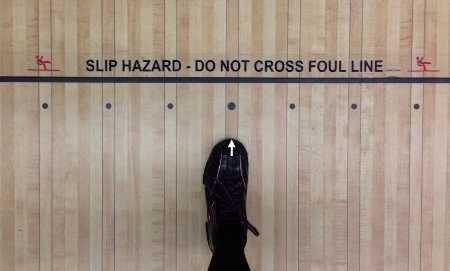Competitive Moves
Competitive Moves
"Move on the approach? What for? I’m comfortable where I am at. I like standing on the big dot and looking at the second arrow, don’t make me move."

Well, with that philosophy you might find yourself at the bottom of the bowling sheet. Making moves on the approach will help you to maintain your strike target throughout the night and being open minded to moves you don’t often make, can put you one step ahead of your opponent.
Once you find your strike target, as the ball goes high on the head pin ( or touches the 2 pin for a right-hander, the 3 pin for a left-hander) it is time to move on the approach so your ball is flush in the pocket once again.
Move just a few:
Off your strike target, move your feet a few boards (or inches) to the left and your eyes one board (or inch) to the left of where you were spotting. This will give you a slight angular move with very little angle change.
If your ball is barely hitting the head pin (going light), it is time to make a move to the right with your feet and your eyes. Move your feet a few boards to the right and keep your target the same. This also creates a slight angular move that will get you back into the pocket.

Make sure to watch what your ball is doing, oh and that you threw it good, so you can make the correct adjustment to stay one strike ahead of your opponent. The approach is wide and has a lot of space for adjustments, so don’t be afraid to continue to move until you feel you are back where you need to be, striking!
Advanced players make a move:
For a more advanced player tackling a modified house pattern or sport condition, you may use two different types of adjustments. The first adjustment called “primary adjustments,” is when you make adjustments to one of the following:
- Change bowling balls.
- Move your foot position on the approach.
- Change your target(s) on the lane to keep your ball in the pocket.
Choosing one or two of these suggestions will change your angle and ball motion, so make sure you are comfortable with your decision and make a good solid shot.
“Secondary adjustments,” are:
- Changing your tempo (foot speed which will change your ball speed).
- Loft (this does not mean hit the roof).
- Changing your release to adjust for pin carry, (you know that pesky 7 or 10 pin).
Remember, execution and confidence in your shot will get you back into the pocket resulting in higher scores.
Key to consistency when making moves on the approach:
Keep in mind that you should only make foot position adjustments if you’re finishing in the same spot at the foul line and rolling the ball consistently in the same area on the lane. If you’re not consistent from shot-to-shot, make the necessary physical game correction before making a “primary adjustment” on the approach.
If the first picture below the bowlers foot finishes on the 20th board and in the second picture the 24th board. Don’t let this inconsistency fool you into the wrong competitive move. Just as you need to watch what your ball is doing as it goes down the lane, making sure you slide in the same spot consistently is just as important in seeking the strike zone.






